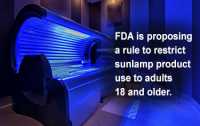19 Dec FDA Proposes Restricting Sunlamps To Adults: Tanning = Skin Damage

Dr. Jennifer Stein
MedicalResearch.com Interview with:
Dr. Jennifer Stein MD
Associate Professor
Department of Ronald O. Perelman
Department of Dermatology
NYU Langone Medical Center
Medical Research: What is the background for this FDA decision? What is the issue surrounding tanning beds?
Dr. Stein: This is an important proposal from the FDA because it restricts minors from tanning and requires adults to sign an acknowledgement stating they have been informed about the risks of tanning.
There is clear evidence that indoor tanning significantly increases a person’s risk for skin cancer, including melanoma, a potentially deadly form of skin cancer.
It is important to protect young people from the dangers of tanning beds, especially because many patients report that they started indoor tanning as teens. There are 1.6 million minors using tanning beds every year.
MedicalResearch: What is the problem with tanning? Isn’t a tan better than a sunburn?
Dr. Stein: Tanning beds deliver intense amounts of UVA. We know that UVA penetrates deep into the skin and causes mutations that lead to skin cancers, including melanoma. Tanning is a sign that skin cells have been damaged by UV light.
Medical Research: What should clinicians and patients take away from your report?
Dr. Stein: This sends an important message to patients that tanning beds are not safe, and parents should not allow their teens to use tanning beds.
As clinicians, it is our job to remind patients not to use tanning beds to help them decrease their risk of melanoma.
Medical Research: What recommendations do you have for future research as a result of this study?
Dr. Stein: We try to teach families how to protect their skin while enjoying a healthy outdoor lifestyle. Sun protection doesn’t mean that you have to live like a vampire.
Below are some important tips:
- Avoid the midday sun when it’s most intense
- Seek the shade
- Wear protective clothing, a hat with a wide brim and sunglasses – the more clothing you’re wearing the less sunscreen you need.
- Apply at least an SPF 30 broad spectrum sunscreen to uncovered areas and re-apply every 2 hours.
Citation:

FDA Proposes New Safety Measures for Indoor Tanning Devices: The Facts
Last Updated on December 19, 2015 by Marie Benz MD FAAD
